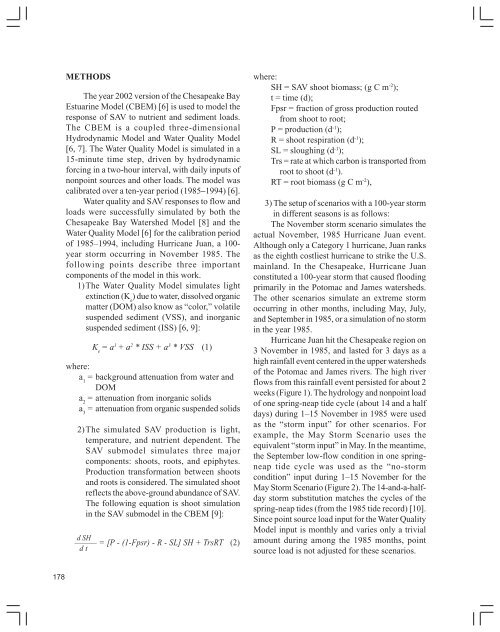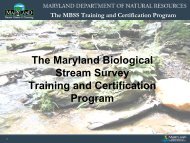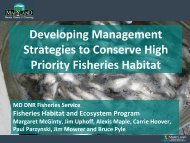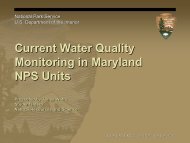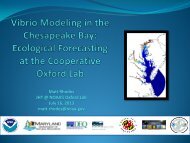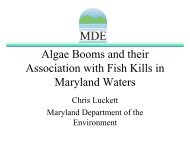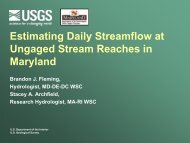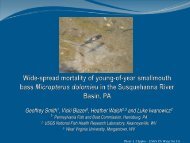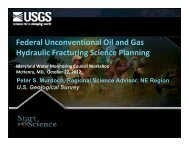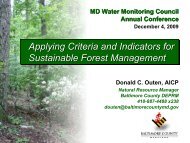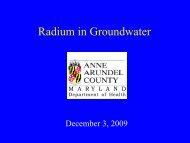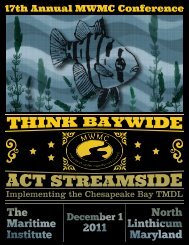Effect of Timing of Extreme Storms on Chesapeake - Maryland ...
Effect of Timing of Extreme Storms on Chesapeake - Maryland ...
Effect of Timing of Extreme Storms on Chesapeake - Maryland ...
You also want an ePaper? Increase the reach of your titles
YUMPU automatically turns print PDFs into web optimized ePapers that Google loves.
178<br />
METHODS<br />
The year 2002 versi<strong>on</strong> <str<strong>on</strong>g>of</str<strong>on</strong>g> the <strong>Chesapeake</strong> Bay<br />
Estuarine Model (CBEM) [6] is used to model the<br />
resp<strong>on</strong>se <str<strong>on</strong>g>of</str<strong>on</strong>g> SAV to nutrient and sediment loads.<br />
The CBEM is a coupled three-dimensi<strong>on</strong>al<br />
Hydrodynamic Model and Water Quality Model<br />
[6, 7]. The Water Quality Model is simulated in a<br />
15-minute time step, driven by hydrodynamic<br />
forcing in a two-hour interval, with daily inputs <str<strong>on</strong>g>of</str<strong>on</strong>g><br />
n<strong>on</strong>point sources and other loads. The model was<br />
calibrated over a ten-year period (1985–1994) [6].<br />
Water quality and SAV resp<strong>on</strong>ses to flow and<br />
loads were successfully simulated by both the<br />
<strong>Chesapeake</strong> Bay Watershed Model [8] and the<br />
Water Quality Model [6] for the calibrati<strong>on</strong> period<br />
<str<strong>on</strong>g>of</str<strong>on</strong>g> 1985–1994, including Hurricane Juan, a 100year<br />
storm occurring in November 1985. The<br />
following points describe three important<br />
comp<strong>on</strong>ents <str<strong>on</strong>g>of</str<strong>on</strong>g> the model in this work.<br />
1)The Water Quality Model simulates light<br />
extincti<strong>on</strong> (K e ) due to water, dissolved organic<br />
matter (DOM) also know as “color,” volatile<br />
suspended sediment (VSS), and inorganic<br />
suspended sediment (ISS) [6, 9]:<br />
K e = a 1 + a 2 * ISS + a 3 * VSS (1)<br />
where:<br />
a 1 = background attenuati<strong>on</strong> from water and<br />
DOM<br />
a 2 = attenuati<strong>on</strong> from inorganic solids<br />
a 3 = attenuati<strong>on</strong> from organic suspended solids<br />
2)The simulated SAV producti<strong>on</strong> is light,<br />
temperature, and nutrient dependent. The<br />
SAV submodel simulates three major<br />
comp<strong>on</strong>ents: shoots, roots, and epiphytes.<br />
Producti<strong>on</strong> transformati<strong>on</strong> between shoots<br />
and roots is c<strong>on</strong>sidered. The simulated shoot<br />
reflects the above-ground abundance <str<strong>on</strong>g>of</str<strong>on</strong>g> SAV.<br />
The following equati<strong>on</strong> is shoot simulati<strong>on</strong><br />
in the SAV submodel in the CBEM [9]:<br />
d SH<br />
——— = [P - (1-Fpsr) - R - SL] SH + TrsRT (2)<br />
d t<br />
where:<br />
SH = SAV shoot biomass; (g C m -2 );<br />
t = time (d);<br />
Fpsr = fracti<strong>on</strong> <str<strong>on</strong>g>of</str<strong>on</strong>g> gross producti<strong>on</strong> routed<br />
from shoot to root;<br />
P = producti<strong>on</strong> (d -1 );<br />
R = shoot respirati<strong>on</strong> (d -1 );<br />
SL = sloughing (d -1 );<br />
Trs = rate at which carb<strong>on</strong> is transported from<br />
root to shoot (d -1 ).<br />
RT = root biomass (g C m -2 ),<br />
3) The setup <str<strong>on</strong>g>of</str<strong>on</strong>g> scenarios with a 100-year storm<br />
in different seas<strong>on</strong>s is as follows:<br />
The November storm scenario simulates the<br />
actual November, 1985 Hurricane Juan event.<br />
Although <strong>on</strong>ly a Category 1 hurricane, Juan ranks<br />
as the eighth costliest hurricane to strike the U.S.<br />
mainland. In the <strong>Chesapeake</strong>, Hurricane Juan<br />
c<strong>on</strong>stituted a 100-year storm that caused flooding<br />
primarily in the Potomac and James watersheds.<br />
The other scenarios simulate an extreme storm<br />
occurring in other m<strong>on</strong>ths, including May, July,<br />
and September in 1985, or a simulati<strong>on</strong> <str<strong>on</strong>g>of</str<strong>on</strong>g> no storm<br />
in the year 1985.<br />
Hurricane Juan hit the <strong>Chesapeake</strong> regi<strong>on</strong> <strong>on</strong><br />
3 November in 1985, and lasted for 3 days as a<br />
high rainfall event centered in the upper watersheds<br />
<str<strong>on</strong>g>of</str<strong>on</strong>g> the Potomac and James rivers. The high river<br />
flows from this rainfall event persisted for about 2<br />
weeks (Figure 1). The hydrology and n<strong>on</strong>point load<br />
<str<strong>on</strong>g>of</str<strong>on</strong>g> <strong>on</strong>e spring-neap tide cycle (about 14 and a half<br />
days) during 1–15 November in 1985 were used<br />
as the “storm input” for other scenarios. For<br />
example, the May Storm Scenario uses the<br />
equivalent “storm input” in May. In the meantime,<br />
the September low-flow c<strong>on</strong>diti<strong>on</strong> in <strong>on</strong>e springneap<br />
tide cycle was used as the “no-storm<br />
c<strong>on</strong>diti<strong>on</strong>” input during 1–15 November for the<br />
May Storm Scenario (Figure 2). The 14-and-a-halfday<br />
storm substituti<strong>on</strong> matches the cycles <str<strong>on</strong>g>of</str<strong>on</strong>g> the<br />
spring-neap tides (from the 1985 tide record) [10].<br />
Since point source load input for the Water Quality<br />
Model input is m<strong>on</strong>thly and varies <strong>on</strong>ly a trivial<br />
amount during am<strong>on</strong>g the 1985 m<strong>on</strong>ths, point<br />
source load is not adjusted for these scenarios.


